Many parts of the Boise National Forest are managed for multiple use.
Near Cow Creek summit, west of Mountain Home, Angus cattle graze on mountain slopes. These are known as “rangelands,” which provide nutritious forage for livestock and wildlife.
These are working lands for local ranchers like Charlie Lyons and Jeff Lord. The grazing pastures are a crucial part of their cattle operation.
Just over the hill, people like to go camping, fishing and boating on the South Fork of the Boise River.
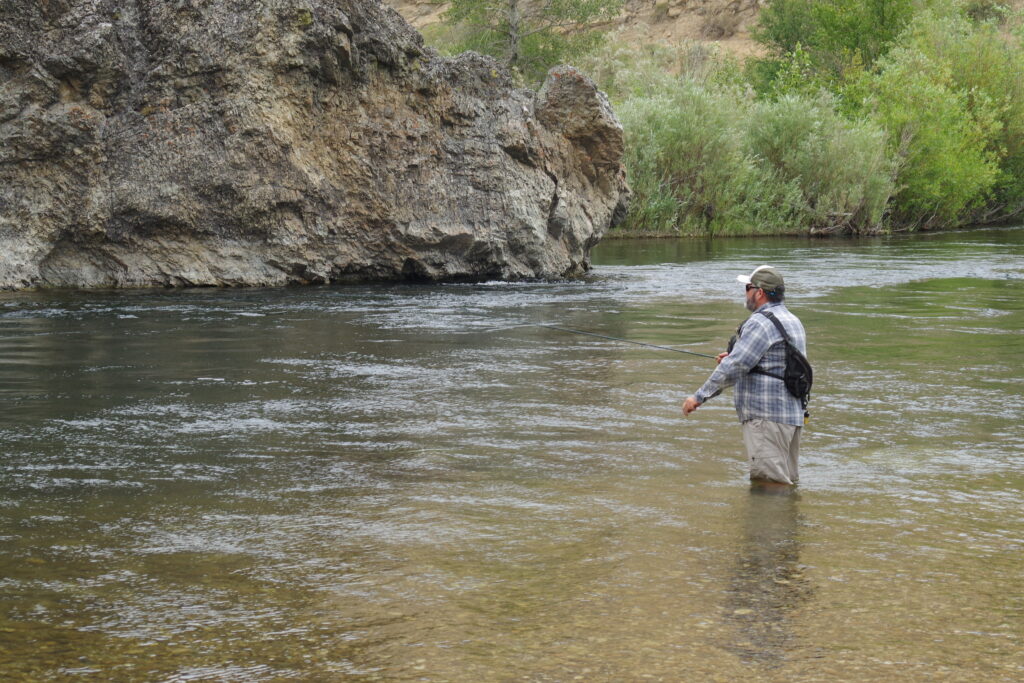
Michael Gibson of Trout Unlimited fly fishes on the South Fork Boise River.
In the Danskin Mountains nearby, people ride motorbikes and ATVs on over 200 miles of trails.
Many people who recreate on the Boise National Forest on a regular basis understand that they need to care for the resource and share it respectfully with others for generations to come.
![]() “That’s our beautiful forest. It’s inescapably important to keep it clean and nice,” says Nate Dallolio, who has been riding motorbikes in the Boise National Forest for many years.
“That’s our beautiful forest. It’s inescapably important to keep it clean and nice,” says Nate Dallolio, who has been riding motorbikes in the Boise National Forest for many years.
Idaho is one of the fastest-growing states in the nation. That’s brought a lot of new visitors to the national forest as well as tourists from out of state.
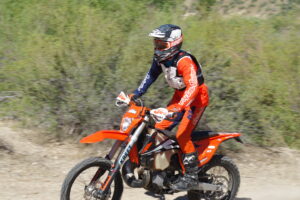
The Danskin Mountains provides more than 200 miles of trails for motorbikes and ATVs.
Newbies may not know much about caring/sharing public lands or multiple use management.
“One thing that’s really important to us is that we’re respecting each other – all of the user groups out here,” said Holly Hampton, Rangeland Management Specialist for the Boise National Forest. “One of the key pieces to getting along is having a little bit of understanding about the uses and resources out there.”
Let’s go over some basics that recreationists need to know about co-existing with livestock on public rangelands, opening and closing gates, corrals, water troughs and more.
Opening and Closing Livestock Gates
Often times, forest visitors will encounter livestock gates on a public access roads.
Many are barbed-wire gates used to keep livestock in a particular grazing pasture.
The Forest Service, Bureau of Land Management and Idaho Department of Lands divided rangelands into grazing allotments with fencing decades ago.

Steven Huffman demonstrates how to open and close a barbed wire gate.
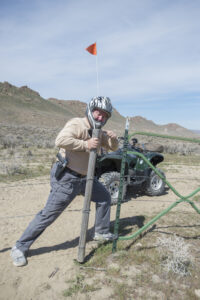
Huffman makes sure the gate is closed securely after he passes through on his ATV.
“Basically this is what allows us to move cattle between allotments and contain them in a confined area,” says Jeff Lord, a Mayfield rancher who grazes cattle in the area.
But the barbed-wire gates can be kind of intimidating. People might wonder, what do I do?
“Yep, probably a little intimidating, reach out and bite you,” jokes Prairie rancher Clay Davison.
“If you happen to come across a gate, be sure to leave a gate as you find it. If that gate is open, leave it open; if the gate is closed, please close the gate,” Hampton says.
Open the wire loop over the wooden pole that holds the gate closed. Pull the wooden pole out of the base of the fence. Open the gate, drive through, close the gate and continue on your way.
Generally, the gates are closed during the summer grazing season. This is when ranchers are rotating cattle through different fenced pastures.
If someone fails to close a gate after passing through, cattle can drift back into a pasture that’s already been grazed for the season.

Grazing allotment map shows the different grazing units in the Cow Creek and South Fork Boise River areas on the Boise National Forest.
“Fences for cattle allotments are really necessary to manage their operation,” Hampton says. “If gates are left open, it can really disrupt the system. If a permittee has just moved all of their livestock through, closed the gate, and then someone leaves that gate open, the cattle might just go back where they came from.”
Adds Davison, “We do rest-rotation grazing on our pasture. The Forest Service has a schedule. We have a meeting each winter to work on the schedule for when we move from one pasture to the next pasture. We don’t want to have to re-gather because someone left a gate open.”
In the fall, ranchers open the gates when it’s time for the cattle to return to the home ranch.
Rancher Jeff Lord demonstrates how he leaves a gate, when it wants it left open. He opens the gate completely and hangs the fence over a post on the other side.
“If you find the gate clear back around, hanging on the fence, please leave it open,” Lord says.
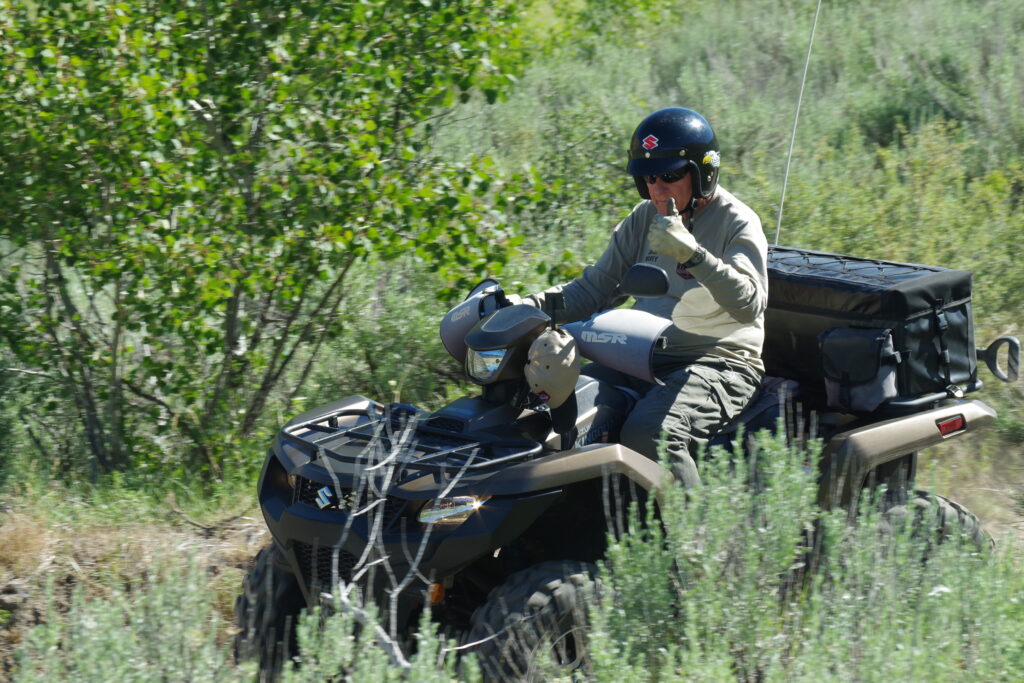
Jim Maxey, ride leader for the Boise ATV Trail Riders, explains how to ride the Danskin Trails safely among other trail users and cattle.
Closing Gates on Trails
Trail users may encounter a barbed-wire gate on a trail or two-track road as well.
On group rides, the Boise ATV Trail Riders have a system for opening and closing gates.
“We use a cone system,” explains Jim Maxey, a ride leader for the club. “The ride leader will open the gate. Drop an orange cone at that gate. That lets the tail-gunner know that gate needs to be closed. We leave it the way we find it.”
What to do if you encounter cattle or sheep on the road?
If you are driving to a trailhead, you may encounter cattle or sheep on the road.
If it’s just a few animals, move forward slowly in your vehicle, at walking speed, and the animals will move out of the way.
If it’s a large group of cattle or sheep, ranchers may be driving the animals to a new pasture. They’re called “cattle drives” or “sheep drives.”
At times like this, it’s best to just pull over and take pictures until the animals have moved off the road. Be patient. These situations are fondly known as a Rural Idaho “traffic jam.”

ATV riders move through cattle respectfully at walking speed and then continue their ride.
What to do if you encounter cattle or sheep on the trail?
“What you do is move your machine at a very slow speed,” Maxey says. “The cattle will disperse different ways and they will allow you to go through them. We’ve been through sheep, and you ride very cautiously. Just creep through them so you don’t excite them or cause a stampede or anything.”
If you’re hiking and you encounter cattle or sheep on the trail, be sure to leash your dog.
If you’re mountain biking, ride through cattle very slowly, at walking speed, and they’ll move out of the way.
If you’re mountain biking and encounter a large group of sheep, it’s best to dismount from your bike and walk through the sheep. Great Pyrenees guard dogs are nearby, and they will see bikers as a threat to the sheep.
Walking your bike diffuses the situation. If guard dogs approach, talk to them and let them know you’re human. Once you’re through the sheep, continue your ride.

This camping group is blocking a livestock corral with their RV and trucks. Please don’t block access to corrals. Find other places to camp.
Livestock Corrals
Livestock corrals are a common sight in the Boise National Forest. They might be empty one day, and the next they’re full of cattle. Corrals are used by ranchers throughout the season.
Please don’t camp in corrals or park vehicles next to corrals, blocking access to them.
Rancher Charlie Lyons explains.
“The facility is built for the management of cattle or sheep or horses. I need access to them,” says Mountain Home rancher Charlie Lyons.
Water Troughs
Water troughs are scattered throughout the forest, providing a critical source of water for livestock and wildlife.
Often times, the water troughs are used as a tool to draw livestock away from creeks and riparian areas.
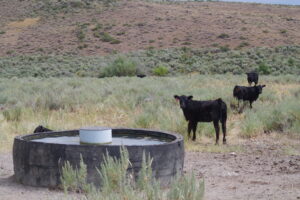
Typical water trough set up on the national forest. The troughs are set up with floats to ensure they don’t overfill. They also have ramps for wildlife to climb out, if critters fall into the water.
“The more dispersed you can keep your cattle, the better,” explains Jeff Lord. “Water is a great way to do that. Water is scarce in Idaho, like anywhere else. That just helps with the management of the resource. If you destroy that improvement, you’re not just getting even with the rancher, you’re hurting the efforts of federal or state employees who are trying to do their job to manage the resource, so you’re really hurting everybody.”
Moreover, in the dry summer months, water is crucial for every living thing.
“Water in our troughs, definitely, is used by just about everything that’s up here, from Hungarian partridge, to sage grouse, elk, deer, antelope, every species that’s up here uses the water.”
The water troughs have ramps inside to allow small critters to climb out of the tank if they fall in.
Sadly, the troughs can be vandalized by people shooting at random targets, riddling the tanks with bullet holes, causing leaks or worse.
The bottom line is that shooting holes in livestock tanks is not only bad form, it’s against the law.
Generally, all of these tips are designed to show respect for different uses on our public rangelands, so we can enjoy the outdoors for generations to come.
“Most people are pretty courteous,” Lord says. “On the whole, it’s a pretty good deal.”
“Care/Share is just respecting and sharing our landscape. This is everybody’s land,” Hampton says.
“Our family has been grazing here for 100 years, and we’d like to keep that going,” adds Davison. “Take care of the ground, what’s what we’re trying to do.”
Steve Stuebner is the writer and producer of Life on the Range, a public education outreach project sponsored by the Idaho Rangeland Resources Commission.
© 2021

